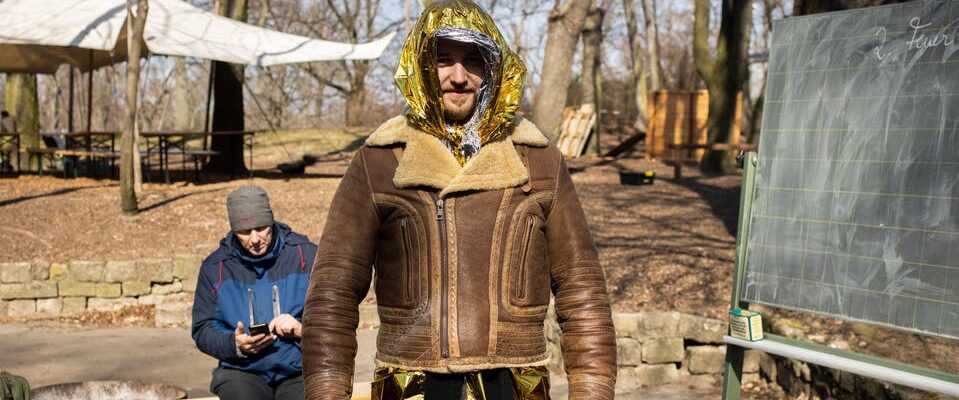The Berlin company Survicamp explains in crash courses what you have to do in natural disasters, cyber attacks or reactor accidents to survive. If you ask the participants why they are taking part, the same keyword always comes up: Ukraine.
Crisis can obviously taste good. Bernd* eats parts of the brown mass with great appetite. It crumbles between the fingers of the wiry 42-year-old as he breaks off pieces of it. “I like to eat it at home sometimes,” he says.
The sweet, floury taste of the product, which is about the size of a bar of soap, is explained by its composition. “Palm fat, sugar, soy protein and roasted wheat provide a quick and high calorie intake,” explains Tom Heinrich as he passes the box of food concentrate around. “The German soldiers in Afghanistan ate it when they were away from the camp for a few days. In hot water it becomes a paste. But after a week you’ve had it.”
The 26-year-old from Brandenburg is leading a “blackout training” event organized by the organizer Survicamp this Sunday in March in Berlin. The knife on his belt identifies him as a man who leaves nothing to chance.
“Tupper party for apocalyptic”?
Six middle-aged men sit in front of him, all expecting the worst – or at least wanting to be prepared for it. The so-called prepper scene does not have a good reputation. Some are not just preparing for a crisis, they are actually longing for it. Reich citizens, for example, who then hope for the collapse of what they consider to be an illegitimate state. At Survicamp, one dissociates oneself from everything political and prefers to speak of “providers” than of preppers. One wants to offer rational crisis preparation and not be part of a subculture that tends to overreact.
But who rehearses on a Sunday for emergencies, while a few hundred meters away people are enjoying the sun in the café at Plötzensee? Civilization-weary neurotics in outdoor clothes, who come to “a Tupper party for apocalyptics”? An article in “Zeit” mocked this in spring 2017. But after two years of a pandemic, a devastating flood and the start of war in the middle of Europe, many people are worried that civilization’s house of cards could collapse faster than expected.
And so, on this morning, well-to-do people come together who would definitely have something to lose if the crisis were to break out. A prosecutor, a policeman, freelancers and an engineer are among them. The course instructor Tom used to be a German and history teacher and now he works for the Red Cross. None of the men makes a cranky impression. Women are missing this Sunday; otherwise, according to the organizer, they make up an average of a third of the participants.
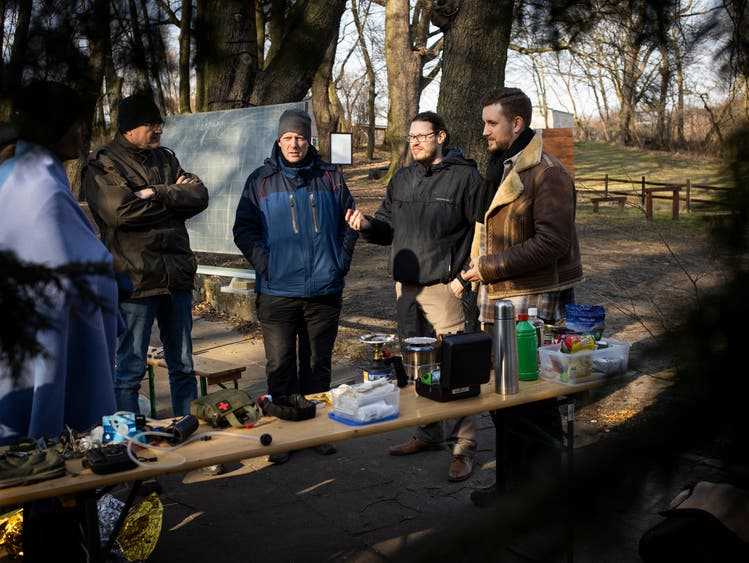
Gas stoves or hand-operated water filters: emergency equipment is available at any camping supply store.
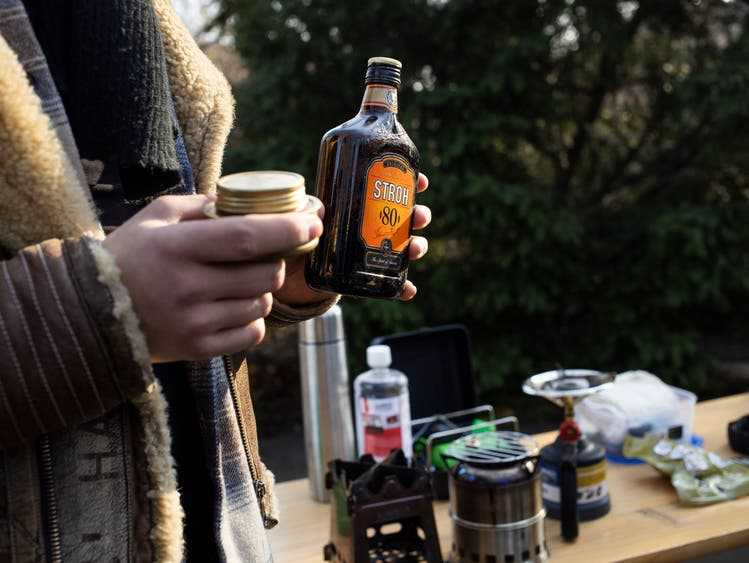
If you don’t have spirits to hand for the stove, high-proof rum will do.
“We’re not training for war here”
One keyword keeps coming up as a decisive factor for participation: Ukraine. “I’m not expecting a Russian attack on Germany,” says Jens.* “But if that’s the case, I want to be prepared.” The freelancer has previously read the survival manual written by Survicamp founder Benjamin Arlet. But theory is one thing, practice is another, he says. When war broke out in Ukraine, he signed up for this course.
“We don’t practice here for war,” says course instructor Tom to clarify, “but for man-made or natural crises.” And he can think of many, also for Germany: natural disasters such as forest fires or floods, financial crises, hacker attacks, but also nuclear or chemical accidents.
It is reminiscent of the year 2005. At that time, parts of the Münsterland were cut off from the power grid for days in freezing temperatures. Heavy snowfall and falling trees brought down power poles. The result was Germany’s longest power outage. A quarter of a million people were affected.
Blackout: This doesn’t just mean failing heaters and electrical appliances. The gas stove, the tap and the toilet flush are then no longer usable. Finally, electric pumps mostly generate the line pressure. In cities, failing traffic lights cause traffic chaos. Subways and elevators come to a standstill. Dialysis patients could be the first victims in their homes. After a few days, water and food become scarce. Gas stations and ATMs are also shutting down. As a result, there is a risk of unrest, looting and violence.
Fear of young looters
Peter* works for the Berlin police and considers such a scenario to be quite realistic. It commemorates the power outage in the south-eastern Berlin district of Treptow-Köpenick in 2019 – the longest the German capital had experienced in decades. At that time, intensive care patients had to be transferred, and goods spoiled on a large scale. “In such situations, the police guard important infrastructure, but not the individual household,” he says. She couldn’t do that either, she didn’t have the strength for that.
50-year-old Friedrich* is also preparing for precisely this scenario. From his point of view, the so-called energy transition increases the probability of a widespread power failure. He himself was covered in his rented apartment for weeks. But he is afraid of young looters. The police will then not be able to control the situation. Luckily he’s a marksman, says Friedrich, and a quick smile crosses his otherwise serious face.
The course instructor Tom is obviously trying not to heat up martial scenarios. It’s not about guarding ravioli cans with a shotgun, he says. In principle, he does not answer questions about the procurement of legal weapons. He wants to give tips on how to satisfy the basic needs of survival. For this purpose, he has laid out dozens of utensils on a beer bench – from a parabolic mirror, with which you can use sunlight to ignite a cotton ball to make a fire, to a breathing mask for NBC incidents.
The course is largely a mixture of camper training and first aid training. Tips from grandma’s time for drying and waking up are also presented. Most of it can also be found in the Brochure of the German Federal Office for Civil Protection and Disaster Assistance, which Tom points out. There it is recommended to have water and food in the house for at least ten days. Tom advises making provisions for at least fourteen days. But durable supplies such as rice and milk powder are not everything. Food ranks well below warmth on the hierarchy of needs.
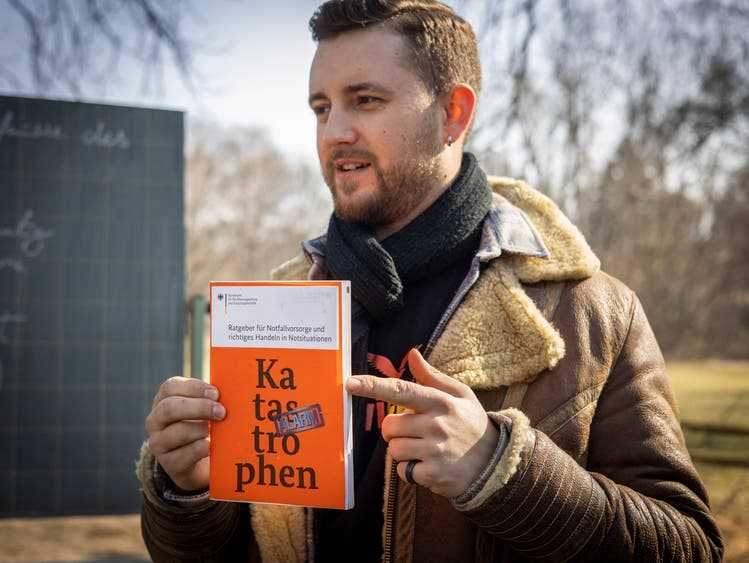
Course instructor Tom Heinrich draws attention to the brochure from the German Federal Office for Civil Protection and Disaster Relief.
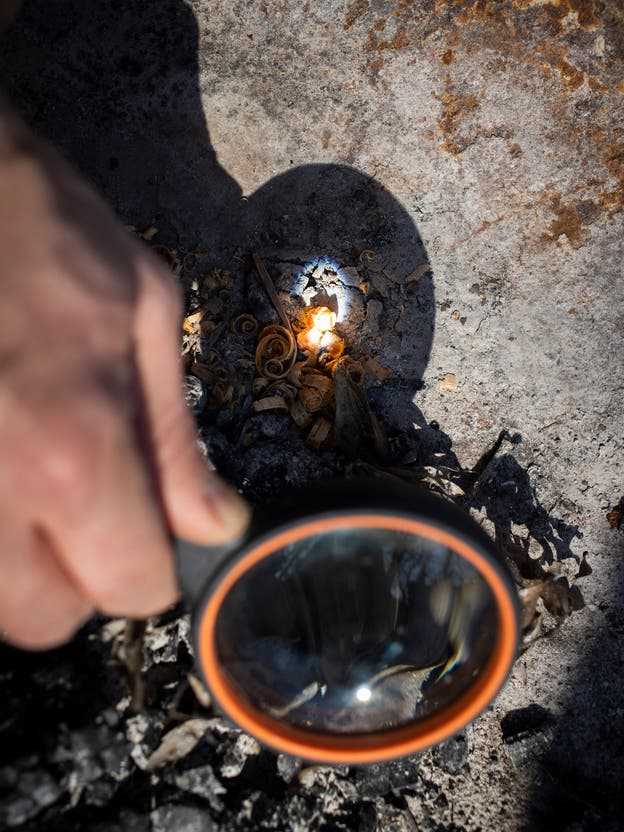
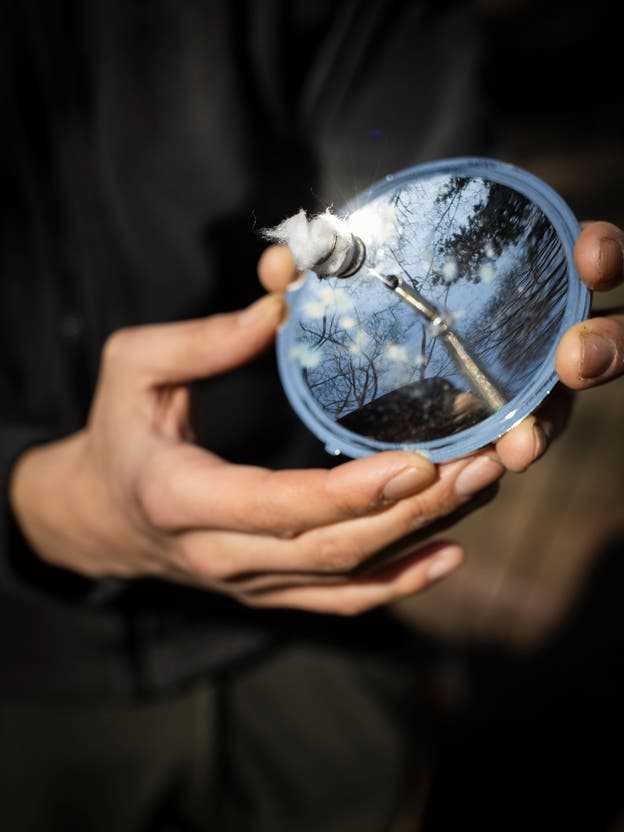
When there are no more matches: With a magnifying glass or a parabolic mirror, the sunlight can be used to ignite fuel.
“The only thing missing is the aluminum hat”
Should the heating fail for a longer period of time in winter, it could be helpful to have a kerosene stove ready, for example, or a home-made heater made of clay pots and tea lights. Stacked on top of each other, these could provide some warmth. But one shouldn’t expect too much from it, says Tom. It is important to seal a room as well as possible and only use one. A rescue blanket also offers excellent protection against the cold at home. Tom shows how to ideally put them on. “All that’s missing is the tinfoil hat,” he jokes as he ties the ends under his chin.
The crisis-proof household should also have cooking facilities or, even better, several alternatives. There is the “hobo oven”: a small metal frame with a perforated underside. Due to the chimney effect, small amounts of fuel are sufficient to generate heat. However, the construction soots a lot, which is why it can only be considered for use on balconies. Gas cookers are particularly suitable for the home. They burn without producing smoke. “Don’t forget to tilt the windows,” says Tom.
The prudent precautionary should also be prepared for a collapse of the water supply. After three days without water, it finally becomes life-threatening. First of all, the distinction between drinking and service water is important. Neither smell nor appearance nor taste reveal whether water is drinkable. Ultimately, you should only trust water from sealed containers. Boiling is therefore always advisable, including the addition of tablets for disinfection. Viruses and bacteria would be reliably killed in this way.
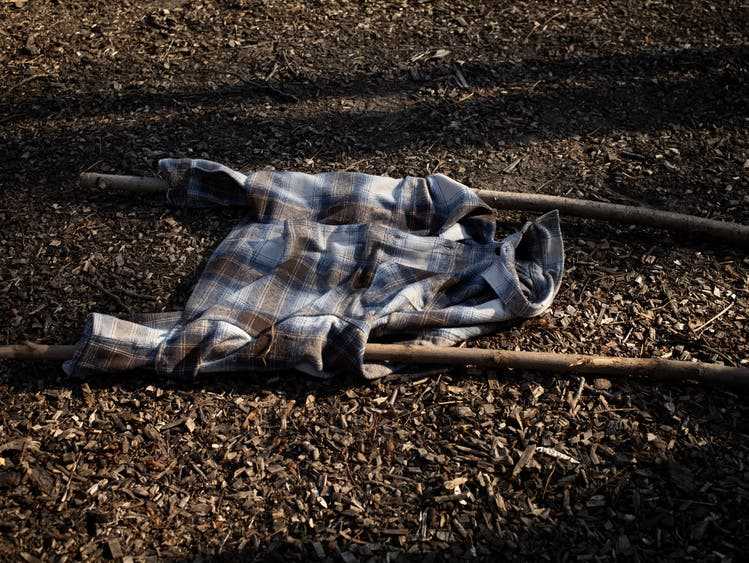
If you don’t have a stretcher to hand, you can make one out of sticks and shirts.
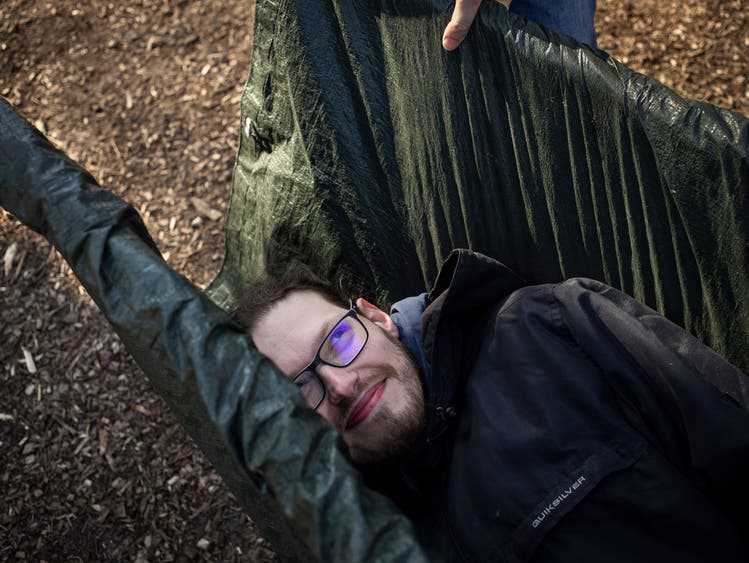
A tarp not only protects against the weather. The tarpaulin is also strong enough to transport casualties in an emergency.
Baking soda will cook the lentils faster
A shot of baking soda also ensures that lentils and other legumes cook faster – important when energy is scarce. There are also resource-saving tricks when preparing rice: simply pour hot water into a thermos flask and after a few hours the grains are cooked through. Hand-operated filters are recommended against suspended matter. However, this is not the way to get rid of heavy metals or chemical contamination. It is best to find out beforehand how polluted natural waters in the area are if you have to use them.
Hygiene also plays an important role during a prolonged power outage. The course leader Tom shows his toiletry bag. It also includes a hand-operated beard trimmer and a razor. Of course, Tom also carries a small whetstone in his everyday luggage. In fact, the young man’s red-blond beard is in great shape.
In the event of a crisis, however, more tangible problems quickly arise. What if, for example, the toilet flush no longer works? Tom presents a self-made toilet chair with canisters that collect liquid and solid faeces separately. The latter could also be composted in a rented apartment with small animal litter, if necessary with soil. “It’s almost odorless,” he says. Urine diluted with water is also an excellent fertilizer for raised beds: “You’ll survive any potato shortage with it.”
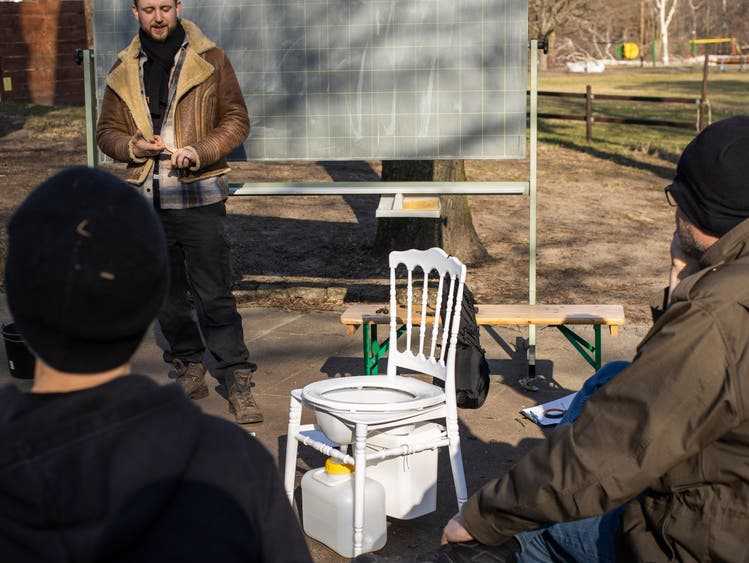
Tom Heinrich shows the toilet chair he built.
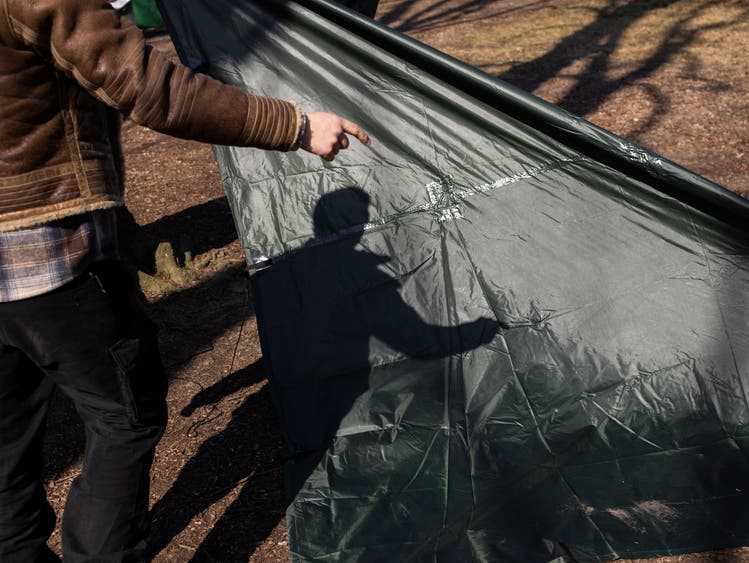
Course participants learn how to set up a temporary emergency shelter with a tarpaulin.
Water bed for necessities
Bernd must have listened with particular interest at this point: urban gardening on the balcony of the big city is of course part of his preventive care. Bundeswehr food is not a solution in the long run. Police officer Peter relies on other resources when it comes to toilets: he has a waterbed. That, he says, would no longer be usable in the event of a power failure because it could no longer be heated. If the worst came to the worst, he would use the 300 liters of water to flush his normal toilet.
At the end of this day full of tips for the crisis toilet, for the perfectly packed escape backpack and the first-aid kit, some think even further. Frank,* an engineer, is preparing a larger Plan B. He and his Ukrainian wife are considering leaving Germany. The northern hemisphere is simply not safe enough anymore. “We applied for visas for New Zealand. They recently made the process easier for Ukrainians,” he says. He doesn’t know yet whether they will dare to take the step in the end. But having the option is important to him. Safe is safe.
* The names of the participants in the “Blackout Training” have been changed to protect their privacy.
